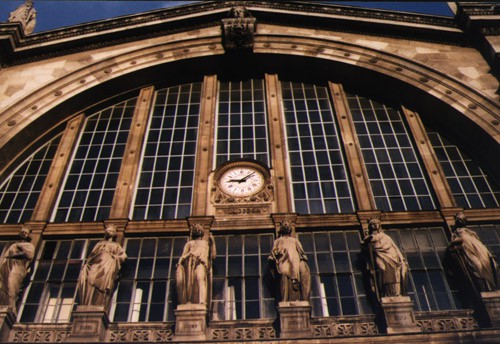Under the Second Empire, the railways in France developed to such an extent that historians have described the period as the “Railway revolution”. From 3 248 km of track in 1851 the network leapt to 16 465 km of track in 1869. France entered the “age of the train”. And this extraordinary rise brought with it the emergence of a new type of building in the heart of the city, the station. Whilst Strasbourg Station (present-day Gare de l'Est) built in ca. 1850 was the first of its type, it was the Gare du Nord station which took the honours for its monumentality and ease of use.
Financed in 1857 by the Compagnie des chemins de fer du Nord (The Northern railway Company) whose managing director was James de Rothschild, the building was to replace the old “embarcadère de Belgique” built by Léonce Reynaud in 1846. The company architects produced some initial designs and these were developed by Jacques-Ignace Hittorff (1792 – 1867) in 1861. Opened in 1864, the Gare du Nord was finally completed in 1865.
James de Rothschild wanted a prestigious building which clearly advertised its purpose. Hitorff's response to this double imperative was to create a glass and iron hall to cover the tracks and to set this next to an ensemble of stone buildings for the public and the staff. These two elements were linked by a monumental façade which hid nothing of functions of the buildings behind it. This 540-foot façade is punctuated by a series of double Ionic pilasters, and these pilasters perfectly highlight the three immense glazed bays which transmit the internal elevation towards the outside and which provide the light required for the inside. It is a great pity that today the great Doric porticoes of the ground floor designed to regulate passenger flow were cut across their width by the addition of a glass porch.
The interior of the station comprises an enormous central hall which is 216 feet wide and 600 feet long. The iron architecture is perfectly adapted to the function of the site. The metal columns with their Composite capitals bear the distinctive hallmarks of Polonceau. Clarity and weightlessness characterise this structure where the feel is almost entirely one of space.
It was one of the company's strongest wishes that the decoration match the grandeur of the building. Indeed the company provided a supplementary budget of 82 000 francs in order to commission from some of the most famous artists of the period 23 allegorical female statues representing the towns served by the railway. To cite the figures of Paris (which dominates the pediment of the central vane of the façade), Boulogne and Compiègne (since special trains left the station taking guests to the famous Compiègne Séries), is to name but the three by Pierre-Jules Cavelier.
Designated a historical monument, the Gare du Nord was the scene of a commemoration in 1990 when President Jacques Chirac inaugurated the change of name of the square facing the station from Place Roubaix to Place Napoleon III. For the first time in Paris, the name of the Emperor was associated with a place and a monument, and the decision to do this was the result of the wish of the French state finally to recognise the modernising and socially aware action of the Emperor with respect to France and Paris in particular.
Gare du Nord Station


